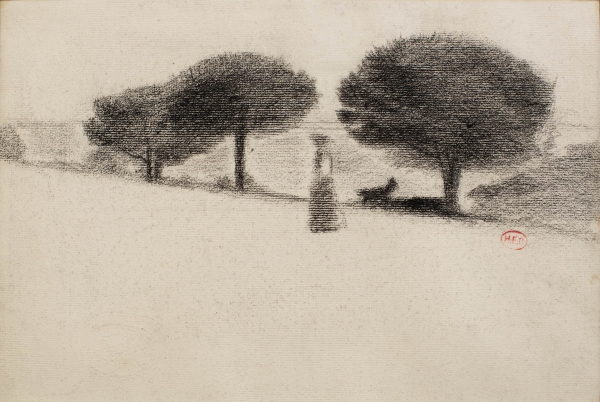Cross, Woman and Dog Among the Umbrella Pines

Henri Edmond CROSS (1856-1910)
Woman and Dog Among the Umbrella Pines
charcoal on laid watermarked paper bearing the Auguste Lepage stamp
24.3 x 31 cm
© MuMa Le Havre / David Fogel
Woman and Dog Among the Umbrella Pines
charcoal on laid watermarked paper bearing the Auguste Lepage stamp
24.3 x 31 cm
© MuMa Le Havre / David Fogel
HD image
In 1891, deeply affected by the death of Seurat, Henri-Edmond Cross (1856–1910) embraced the Neo-Impressionist movement. Also in this year, suffering from rheumatism, he left Paris for Cabasson, in the Var, where he rented a house he called the "Maison perdue". A year later, he had a small cabin built in Saint-Clair, near Le Lavandou, closer to his friend Signac who lived in Saint-Tropez. As a result, the Mediterranean landscape became an endless source of inspiration for him.
While the artist painted many canvases, he also explored the technique of watercolour, which fulfilled his need to work more freely and quickly. His pointillist paintings were thoroughly prepared with series of drawings, some employing the grid method, others with handwritten notes on colours, values, harmonies, and so on.
Cross was chiefly known for his work with watercolours, and yet, like Seurat, he produced Neo-Impressionist drawings. Woman and Dog Among the Umbrella Pines is one of the most exemplary. The technique involves very gently rubbing laid paper—thick paper that retains the mark of its method of manufacture—using a grease pencil (Conté crayon) with black pigments that skip across the textured paper to produce a shimmering effect on the surface. The crayon is not used to draw contours, but to bring out shapes and tie them together in a continuum of chiaroscuro.
With great sobriety, the drawing captures the essence of the Mediterranean landscape, bathed in a light that illuminates everything it touches. The shadowless woman going for a stroll appears to be subtly floating above the luminous, unspoilt ground. The wide, empty foreground, a road or path, places the scene at a distance and imparts the character with a kind of detached and silent solitude. Everything suggests a sense of deep tranquility, a moment that is not fixed in time, but captured in the peacefully slow pace of perfect harmony between people and nature.
While the artist painted many canvases, he also explored the technique of watercolour, which fulfilled his need to work more freely and quickly. His pointillist paintings were thoroughly prepared with series of drawings, some employing the grid method, others with handwritten notes on colours, values, harmonies, and so on.
Cross was chiefly known for his work with watercolours, and yet, like Seurat, he produced Neo-Impressionist drawings. Woman and Dog Among the Umbrella Pines is one of the most exemplary. The technique involves very gently rubbing laid paper—thick paper that retains the mark of its method of manufacture—using a grease pencil (Conté crayon) with black pigments that skip across the textured paper to produce a shimmering effect on the surface. The crayon is not used to draw contours, but to bring out shapes and tie them together in a continuum of chiaroscuro.
With great sobriety, the drawing captures the essence of the Mediterranean landscape, bathed in a light that illuminates everything it touches. The shadowless woman going for a stroll appears to be subtly floating above the luminous, unspoilt ground. The wide, empty foreground, a road or path, places the scene at a distance and imparts the character with a kind of detached and silent solitude. Everything suggests a sense of deep tranquility, a moment that is not fixed in time, but captured in the peacefully slow pace of perfect harmony between people and nature.

















